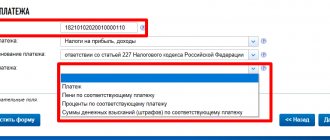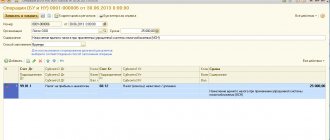How is land tax calculated?
The Federal Tax Service determines the amount for each land owner based on information from Rosreestr: cadastral value and category of land.
From April to September, tax officials send notifications to the registration address or the location of the site. The owner of the property must pay for the previous year by December 1 of the current year.
The amount is determined based on the length of time the land has been owned and the number of owners. When calculating, 4 options are used:
- For a full calendar year.
- For part of the year.
- For a share.
- According to the tax rate.
IMPORTANT! The owner is not exempt from paying unless he receives a receipt. The defaulter is issued a fine of 20% of the assigned amount. Tax officers have the right to demand payment of debt and penalties within three years from the date of purchase of real estate.
The procedure for calculating land tax
To calculate land tax, you need to multiply the tax base (cadastral value of the plot) by the corresponding tax rate. This calculation is performed after a specific calendar year. In this case, Article 396 of the Tax Code takes into account the following factors that also influence the amount of this mandatory payment:
- How many months during a particular calendar year did the taxpayer own the property? If the period of ownership is less than 12 months, this is taken into account in the calculations - the period of ownership coefficient is used (the number of months of ownership is divided by 12).
- Has the cadastral price of the taxable plot changed during a specific calendar year? Changes in this indicator also affect the calculation (tax amounts before and after this change are determined separately, and the results of these calculations are then added together)
- Does the taxpayer have the right to use a deduction (that is, reduce the tax base). Sometimes a citizen does not acquire such a right immediately, but over the course of a year (starting from a certain month).
Example calculation
On April 20, 2020, a citizen acquired a land plot. Area – 20 acres. The intended purpose is the construction of individual housing. The cadastral price as of 01/01/2019 is 500,000 rubles. The tax rate is 1.5%. At the beginning of October 2020, this citizen was assigned disability (group 2), which allowed him to apply the deduction. It is necessary to calculate the land tax.
The following calculation algorithm is used:
- The total period of possession throughout the year is specified - 8 months (according to paragraph 3 of paragraph 7 of Article 396 of the Tax Code), that is, from May 2020 to December 2020 inclusive.
- For the first 5 months - from May 2020 to September 2020 inclusive - the base was determined without applying a deduction. The period of possession coefficient is 5/12. Thus, for this period the tax amount was calculated from 20 acres and amounted to 3,125 rubles (1.5% × 500,000 × 5/12).
- For the next 3 months - from October 2020 to December 2019 inclusive - the base was determined using a deduction (decreased by the cadastral price of 6 acres) and amounted to 350,000 rubles (500,000 × (20-6)/20). The tenure ratio is 3/12. Thus, the tax amount for this period was calculated from 14 acres and amounted to 1,312.50 rubles (1.5% × 350,000 × 3/12).
- The total tax amount is 4437.50 rubles (add 3125 and 1312.50).
Features of calculation for legal entities
Based on the results of the tax period, a legal entity calculates land tax as follows: from the annual tax amount equal to the product of the base and the rate, the amount of advance payments for this tax paid during the calendar year is subtracted. This procedure is stipulated by paragraph 5 of Article 396 of the Tax Code.
If the reporting period corresponds to a calendar quarter, for each such period (1st, 2nd and 3rd quarter) the taxpayer pays an advance payment equal to 25% of the annual tax amount (the product of the tax base and rate). This requirement is stipulated by paragraph 6 of Article 396 of the Tax Code.
If you have any questions, you can ask them free of charge to the company’s lawyers in the form provided below. An answer from a competent specialist will help you make the right decision.
Share with friends:
Calculation of land tax based on cadastral value
Rosreestr employees calculate the cadastral value of land every five years based on a number of factors:
- location;
- squares;
- socio-economic development of the region;
- soil quality;
- infrastructure;
- availability of amenities and residential buildings.
Information on the estimated cost is contained in the USRN database. It can be found on the Rosreestr website; to do this, you need to enter the cadastral number or address of the site. Or order a paid statement.
An electronic statement costs 250 rubles for citizens and 700 rubles for organizations, and a paper statement costs 400 rubles. and 1100 rub. respectively.
If the owner considers the cadastral value to be too high, he writes a statement to Rosreestr and asks to recalculate the price, and in case of refusal, he goes to court.
To independently calculate the land tax, you need to know two parameters: the cadastral price and the tariff rate. The tax rate is set by the state. Regional authorities, according to the Tax Code, have the right to reduce its size.
The law sets a rate of 0.3% for agricultural land and housing construction. To calculate the tax on other plots – 1.5%. The government has the right to reduce this figure to 0.1% or introduce benefits for individual citizens. The difference is compensated from the local budget.
ATTENTION! Indigenous residents of the Far East, Siberia and the Far North are exempt from paying taxes.
Who calculates the base and tax amount
Legal entities independently calculate the base and amount of land tax according to the Unified State Register of Real Estate. These calculations are made for each taxable asset. These requirements are established in paragraph 3 of Art. 391 Tax Code and paragraph 2 of Art. 396 NK. The tax is paid by the legal entity at the end of each reporting period (in advance payments) and each tax period (finally).
For individual taxpayers, the base and amount of land tax are calculated by the divisions of the Federal Tax Service according to the Unified State Register of Real Estate information provided by Rosreestr authorities. The citizen receives a notification from the tax service about the transfer of the fee. Such conditions are provided for in paragraph 4 of Article 391 of the Tax Code and paragraph 3 of Article 396 of the Tax Code.
Formula for calculating tax
The general formula for calculating land tax is established by the Tax Code of the Russian Federation and looks like this:
interest rate × cadastral value × number of shares.
Tax officers enter a time coefficient if the owner has owned the land for less than a year, and determine it by dividing the number of months in ownership by 12.
The local administration can reduce the tax amount if the owner of the land belongs to the category of beneficiaries.
Types of odds
They are listed in Article 396 of the Tax Code, which deals with the procedure for calculating land tax.
The reasons for applying the coefficient may occur if:
- a plot of land was purchased for housing construction, the coefficient depends on the duration of construction (Kuv);
- the plot was owned by taxpayers for an incomplete number of calendar months per year - depending on the time of use (Q);
- During the tax period, the taxpayer was assigned or canceled a benefit (Cl).
The coefficient Kv is the ratio of the number of whole months of land ownership to the number of months in a year.
However, if ownership rights appeared before the 15th or disappeared after the 15th inclusive, part of the month is accepted as full.
Conversely, if ownership arose after the 15th or disappeared before the 15th, the month is excluded from the time of ownership of the land plot.
For example, the right to property was registered on October 11. The calendar year is 12 months, until January 1 there are 2 full months and 1, which is accepted as full.
Then:
Kv = 3 ÷ 12 = 0.25
However, if the right is registered on October 21, then:
Kv = 2 ÷ 12 = 0.167.
As with any other tax, land tax has a list of beneficiaries. The application of benefits is regulated at the following levels:
- Federal - provisions of the Tax Code of the Russian Federation, Chapter 31 - benefits provided in accordance with Part 5 of Article 391.
- regional - each subject of the Russian Federation must set tax rates for a specific category of payers every year, as well as an additional list of beneficiaries, in addition to those established by the Tax Code of the Russian Federation.
In this case, the benefit is taken into account using the coefficient Kl, as the ratio of full months without applying the benefit to the number of calendar months in a year. An incomplete month of the beginning or end of the right to a benefit is taken as a full month.
If the right to a tax benefit arose on July 2, then:
Cl = 6 ÷ 12 = 0.5.
Examples of calculations
Examples of standard tax calculations:
- A plot of land in SNT with a cadastral price of 150,000 rubles has been owned for more than a year, has one owner, and there are no benefits. The tax amount will be: 150,000 × 0.3% × 1 = 450 rubles.
- Land for individual housing construction costing 250,000 rubles. It was in the possession of one owner for three months, then was sold. The amount is divided between the seller and the buyer: 250,000 × 0.3% × 3 ⁄ 12 = 187.50 rubles. for the first owner. For the second: 250,000 × 0.3% × 9 ⁄ 12 = 562.5 rubles.
- The owner owns half of the plot. The land is not classified as horticultural, residential or defense land. Price – 160,000 rub. The tax amount will be: 160,000 × 1.5% × 0.5 = 1,200 rubles.
- A garden plot is valued at RUR 200,000. and belongs to a combat veteran who has a benefit of 10,000 rubles. Tax amount for the beneficiary: (200,000 – 10,000) × 0.3% × 1 = 570 rubles.
If the owner has not received a receipt, he can find out the amount of debt on the State Services portal, in his personal account on the Federal Tax Service website or at the regional tax office.
How can an individual or individual entrepreneur find out the land tax debt if the notification has not been received?
A visit to the nearest Federal Tax Service allows you to find out the land tax. However, this takes time. The easiest way to search for existing debt is to use the Internet.
So, in your personal account on the Federal Tax Service website you can see all the information about the tax, download a receipt for its payment and even pay the tax online using a card from any bank. To do this, you need to register in the taxpayer’s personal account on the Federal Tax Service website, having previously visited any tax office in order to issue a card indicating your login and temporary password. Based on this card, access to the Federal Tax Service website is provided. After the first login, you should change your password in order to ensure the confidentiality of subsequent visits to your personal account.
Your personal account allows you to see all the information on land and other taxes. If the user does not agree with the charges, he can inform the Federal Tax Service about this by sending a corresponding request.
You can also determine land tax debt on the State Services Portal (gosuslugi.ru) or the FSSP website (fssprus.ru). However, as for the FSSP website, it should be understood that information about debts appears on it already in the process of judicial collection.
It is currently not possible to find out about land tax debts on the Internet without registering (by TIN, for example).
Calculator
To calculate land tax, you must fill in the following fields:
- Cadastral value (minus the amount of the benefit, if any).
- Interest rate (0.3% for agricultural land and housing construction. To calculate the tax on other plots - 1.5%).
- Shared ownership. For example: 1/3 - 33%, 1/2 - 50%, 1 - 100%.
- If the owner owns the plot for less than a year, then the actual number of months is indicated.
The necessary information for filling out the fields is indicated in the extract from the Unified State Register and on the Rosreestr website.



